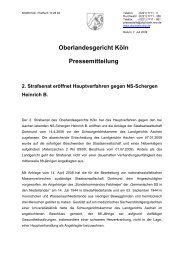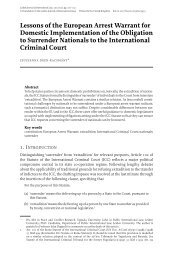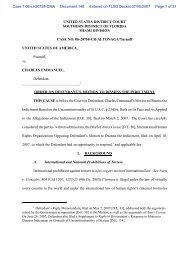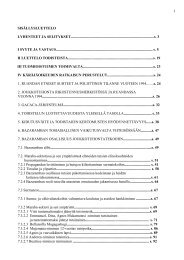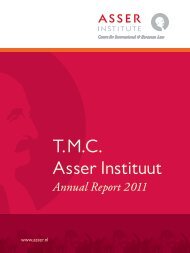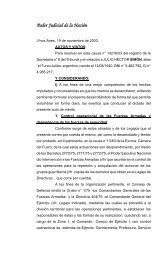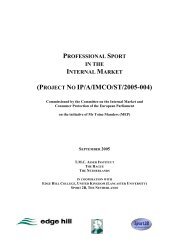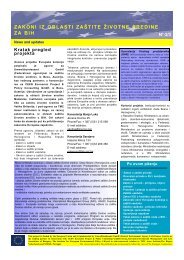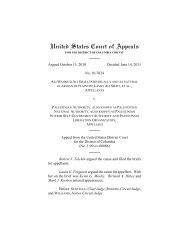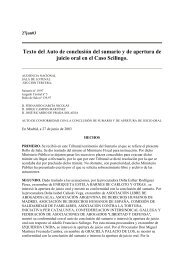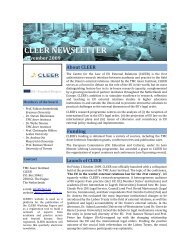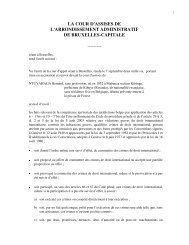Islj 2009 3-4 - TMC Asser Instituut
Islj 2009 3-4 - TMC Asser Instituut
Islj 2009 3-4 - TMC Asser Instituut
Create successful ePaper yourself
Turn your PDF publications into a flip-book with our unique Google optimized e-Paper software.
negotiating on behalf of a player with the club and they receive a commission<br />
for the service.<br />
Nowadays, the sports agents are part of the professional sport culture.<br />
They have a significant power in the market, some people even<br />
say that they have too much power. In such a way, that they can influence<br />
the migration flows, transfer fees and wages in the way they want<br />
it. It used to be a two-sided relationship between a player and a club.<br />
Today, the sports agent is the third actor in the market.<br />
So, the two-sided relationship evolved over time towards a threeway<br />
relationship, consisting of the clubs, players and the sports<br />
agents.<br />
There is a principal-agent problem in the three-way relationship,<br />
because the sports agent is negotiating on the behalf of the athlete.<br />
The third party is not involved in the traditional principal agent problem,<br />
but we have to keep the clubs in mind. They can influence the<br />
principal-agent relationship between the player and his sports agent,<br />
by aligning the interests of the clubs more with the sports agents. The<br />
athlete and sports agent have a conflict of interest and there is information<br />
asymmetry, because every actor is trying to maximize his own<br />
profits. A sports agent has more knowhow of the market and he has<br />
more experience in the bargaining process. For the athlete, it is important<br />
to give the right incentives to the sports agent in order to align<br />
the interest of the sports agent and the athlete. If a sports agent is<br />
negotiating a contract in the interest of the player, then this can be<br />
seen as bargaining at arm’s length (Bebchuk and Fried, 2004). The<br />
principal-agent problem and the bargaining at arm’s length will be<br />
discussed in respectively chapter 2.3 and chapter 2.4.<br />
Authorities or private institutions have to set some regulations in<br />
order to constrain the power of a sports agent and the ability to abuse<br />
a player (Sobel, 1987). Without any regulation, the power of a sports<br />
agent or a group of sports agents might become too strong.<br />
Nowadays, there are regulations in the market of sports agents. A<br />
good example is the license, which is needed to be a sports agent in<br />
most sports. If the requirements for such a license are high, the quality<br />
of the sports agent increases.<br />
Furthermore, there is not much research available in the field of<br />
sports agents in Europe, in contrast with the United States of<br />
America. The literature about the sports agents in USA is extensive<br />
and it can be used for sports agents in Europe, but there is still not a<br />
clear guideline how to regulate the market for sports agents.<br />
1.1. Problem statement<br />
In this research, the focus will be on the regulation in the market of<br />
sports agents. When thinking about the regulation in the market of<br />
sports agents, several questions arise. Why is there a need for the market<br />
for sports agents to be regulated? More specifically, which problems<br />
or market failures arise in an unregulated market for sports<br />
agents? Can these problems be solved by regulation, and if so, how?<br />
What can be learned from regulation of the market for sports<br />
agents in the USA for Europe and in particular the Netherlands? In<br />
order to narrow the research, the following problem statement is formulated:<br />
“How does the market for sports agents in football look like in the<br />
Netherlands and is the regulation in place enough to create an efficient<br />
market?”<br />
In order to answer the research question it is necessary to set up some<br />
sub questions. The first would be: What does the academic literature<br />
say about the market of sports agents and what economic theories are<br />
useful for this market? The second question is: What regulations are<br />
3 The players received more bargaining<br />
power during contract negotiations, as<br />
explained in the paragraphs above.<br />
4 Not the same as European football.<br />
5 The highest league in the Netherlands is<br />
the ‘Eredivisie’ and the second league<br />
calls ‘Eerste Divisie’. It used to be the<br />
case that the clubs in the second highest<br />
league could not relegate. This season<br />
the clubs can relegate.<br />
6 The regulations set in the USA on the<br />
clubs are to maintain the competitive<br />
balance within the competition. It is a<br />
reaction on the closed leagues and playoff<br />
system. (Groot, 2008).<br />
7 The functions will be explained in chapter<br />
2.1.<br />
in place in the market of sports agents in the Netherlands? After that,<br />
the question arises: How does the market of sports agents looks like<br />
in the Netherlands? Finally: What experiences do the actors in the<br />
market have with the different regulations in place?<br />
So, I will first start with a theoretical framework of economic theories.<br />
In order to understand the market for sports agents, it is good<br />
to explain shortly how the labor market for players works. Further<br />
examples of theories are moral hazard, adverse selection, principalagent<br />
problem and more. After that, there will be a short review of the<br />
literature on this topic. At this moment, there is not yet a clear<br />
overview of the market for sports agents in the Netherlands. So, after<br />
the literature discussion I will give the view of different actors on the<br />
market. In order to this, I have done interviews as an empirical study.<br />
The actors are the clubs, sports agents and the players. The focus in<br />
the research will be on Dutch football. At last, there will be a conclusion,<br />
with the findings of this study.<br />
1.2. Differences between USA and Europe<br />
In this chapter, some of the important differences and similarities of<br />
USA sports and European sports will be discussed. It is important to<br />
know the differences, because the most of the academic literature is<br />
from the USA.<br />
First, it is important to know which sports are called USA sports or<br />
European sports. In the USA there<br />
are four main sports, which are played on a great scale throughout<br />
USA. The four sports are Ice hockey, Basketball, Baseball and<br />
American Football. 4 In Europe, there is one sport throughout the<br />
continent, which is very popular. This sport is football or like the<br />
English people prefer to say it, it is soccer. In this research, I will use<br />
the name football.<br />
In the leagues in USA there are closed leagues, which are not in<br />
place in Europe. This means that a club cannot relegate to a lower<br />
level. The implication is that the competition at the bottom of the<br />
league is not very exciting. In Europe there are open leagues. It is different<br />
in every country until which level. In the Netherlands, for the<br />
first season, the league became an open league. 5 The clubs in the second<br />
highest level can relegate to a lower league. To determine the<br />
champion in the USA, the clubs have to play playoffs at the end of<br />
the season. In Europe it is determined by playing a competition without<br />
playoffs.<br />
In the USA there are several regulations on the clubs, which<br />
restricts the clubs in buying players. For example, there is a rookie<br />
draft. It means, that the club which ended at the bottom of the league<br />
can choose, as first, a young player (rookie). So, the worst clubs can<br />
choose, in theory, the best player for their squad. Furthermore, there<br />
is the salary cap. The salary cap means that a club has a limitation on<br />
the salary expenditures. It is not possible for the club to get a lot of<br />
star players for a high salary, because that would go beyond the salary<br />
cap. Another example is gate-sharing. 6 In Europe there are no regulations<br />
like these, which limits the clubs.<br />
So, you can conclude that the literature from the USA is written<br />
from another perspective and another landscape, in comparison with<br />
Europe. That is why the literature from the USA cannot be translated<br />
fully to the European market.<br />
1.3. Methodology<br />
The methodology used, in illustrating the market of sports agents, is<br />
interviews. To make a clear picture of the market of sports agents, it<br />
is necessary to speak all different actors within the market.<br />
Due to the lack of time, it is not possible to speak with every sports<br />
agent active in the Netherlands.<br />
There are some companies active in the Netherlands, which are<br />
focused on the monitoring of professional footballers. So, I have spoken<br />
with two sports agents in such a company active. These companies<br />
are trying to offer function one until function five to all the players.<br />
7 There are other actors active, besides the sports agent. The players<br />
and clubs are also part of this market. The players are the clients<br />
of the sports agents and the clubs also can be a client of a sports agent<br />
or they are the negotiating partner, when the sports agent is represent-<br />
A RT I C L E S<br />
<strong>2009</strong>/3-4 71



